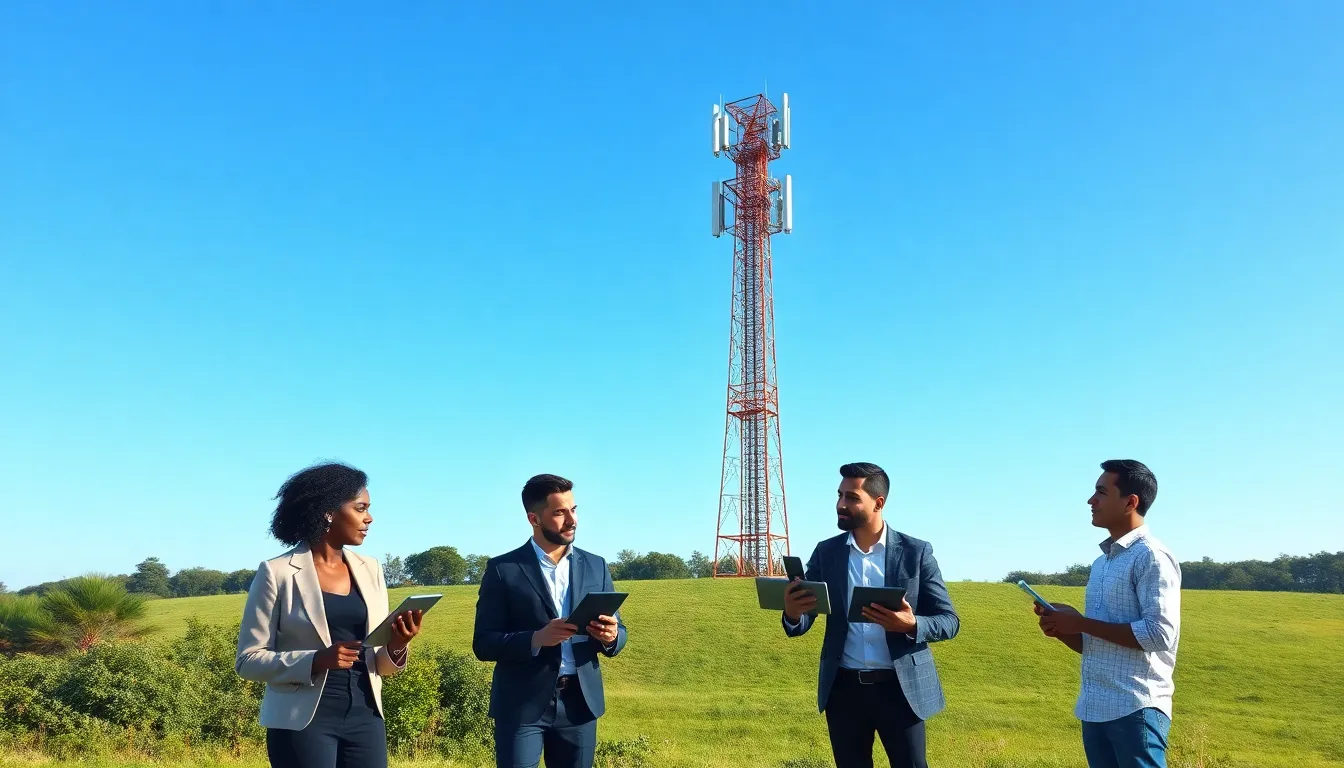In a world where staying connected is as crucial as breathing, motive energy telecommunications is shaking things up like a double shot of espresso. Imagine a network that not only powers your devices but also fuels your ambitions. This isn’t just about making calls or sending texts; it’s about creating a seamless experience that keeps you in the loop while you conquer the day.
motive energy telecommunications
Motive energy telecommunications revolutionizes how individuals interact with technology. This system integrates various energy sources, ensuring constant connectivity for users. Key components include smart devices, network infrastructure, and data management tools. These elements work together to enable efficient communication, whether for personal use or business operations.
Motive energy telecommunications supports diverse applications beyond traditional messaging services. Enhanced data transmission enhances multimedia streaming, online gaming, and virtual reality experiences. Energy-efficient technologies play a vital role in maintaining robust network performance. Users benefit from reduced latency and improved reliability, fostering seamless interactions throughout their day.
Many industries leverage motive energy telecommunications to optimize their operations. For instance, the transportation sector utilizes this technology to streamline logistics and improve route management. Additionally, healthcare systems enhance patient monitoring and communication through real-time data sharing. The education sector, too, embraces this technology for interactive learning experiences.
Growth in this field hinges on advancements in infrastructure and energy sources. Innovations in battery technology and renewable energy solutions drive forward development. As motive energy telecommunications becomes more widespread, users can expect improved services that respond to their evolving needs. Overall, this transformative approach to connectivity shapes how individuals and organizations engage with the world around them.
Key Technologies in Motive Energy Telecommunications

Motive energy telecommunications relies on several advanced technologies that ensure seamless connectivity and robust network performance. These innovations facilitate a wide array of applications across various industries.
Wireless Communication Systems
Wireless communication systems form the backbone of motive energy telecommunications. These systems utilize advanced protocols to enable high-speed data transfer, ensuring users remain connected regardless of their location. Technologies like 5G enhance download speeds and reduce latency, making multimedia streaming and online gaming experiences smoother. The integration of mesh networking further improves coverage, connecting devices in a wide area without relying on traditional infrastructure. Such systems prove essential for enterprises requiring reliable communication to streamline operations and enhance collaboration.
Energy Transfer Mechanisms
Energy transfer mechanisms play a crucial role in motive energy telecommunications. Various solutions, including wireless charging and solar power systems, ensure devices maintain power for prolonged use. Inductive charging technology allows users to charge devices without physical connections, simplifying the user experience. Additionally, advancements in battery technology contribute to energy efficiency, extending device usage time. Renewable energy solutions, such as solar cells integrated into devices, support sustainability while optimizing energy consumption. These mechanisms not only enhance connectivity but also promote environmentally friendly practices across industries.
Applications of Motive Energy Telecommunications
Motive energy telecommunications plays a significant role in various sectors, enhancing efficiency and connectivity.
Industrial Automation
Industrial automation benefits greatly from motive energy telecommunications. Smart sensors and devices communicate in real-time, optimizing production processes. Enhanced connectivity leads to improved data analytics on machine performance, enabling predictive maintenance strategies. Wireless networks support seamless interactions among automated systems, reducing downtime and increasing productivity. Moreover, manufacturers leverage energy-efficient technologies to power equipment sustainably, facilitating eco-friendly practices. Organizations integrating these systems experience improved agility and responsiveness to market demands.
Transportation Systems
Transportation systems increasingly utilize motive energy telecommunications for enhanced operational efficiency. Real-time tracking of vehicles streamlines logistics, ensuring timely deliveries. Public transportation benefits from increased connectivity, allowing passengers to receive updates on schedules and delays instantly. Wireless communication between vehicles promotes safety through features like vehicle-to-vehicle communication. Energy-efficient solutions improve vehicle performance while minimizing environmental impact. As cities embrace smart transportation technologies, users experience more reliable and integrated travel options, transforming the commuting landscape.
Challenges and Limitations
Motive energy telecommunications faces several challenges and limitations that impact its development and implementation. Addressing these hurdles is crucial for maximizing the technology’s potential.
Technical Barriers
Technical barriers hinder the widespread adoption of motive energy telecommunications. Complexities arise in integrating various energy sources and ensuring compatibility among devices. Network infrastructure can struggle to keep up with the required data speeds, especially in rural areas. Reliability remains a significant concern, particularly where conventional systems still dominate. Furthermore, insufficient advancements in energy storage technologies can restrict the longevity of devices and degrade service quality. Overcoming these obstacles requires continuous innovation and collaboration among industry stakeholders.
Regulatory Issues
Regulatory issues also pose significant challenges for motive energy telecommunications. Governments play a critical role in establishing guidelines that affect the deployment and operation of communication networks. Varying regulations across regions can create compliance complexities for service providers. Spectrum allocation and licensing processes can become lengthy and cumbersome, delaying technological advancements. Entrepreneurs and established companies often need to navigate a maze of legal obstacles that can slow market entry. Collaboration with policymakers can foster an environment that supports the technology’s growth and aligns with public interests.
Future Trends in Motive Energy Telecommunications
Advancements in motive energy telecommunications are rapidly transforming user experiences. Enhanced wireless communication systems, particularly through 5G technology, promise significantly faster data transfer rates. Users benefit from reduced latency during multimedia streaming and online gaming, which enhances overall interaction with technology.
Improved mesh networking techniques offer expanded coverage, especially in urban environments. Businesses increasingly rely on effective communication for operational efficiency, making these innovations essential. Sustainability remains a priority as energy-efficient solutions, including wireless charging and solar power systems, become mainstream. This shift not only promotes energy conservation but also supports environmentally friendly practices across various industries.
Optimizing transportation systems showcases the transformative potential of motive energy telecommunications. Real-time vehicle tracking and smart sensors enable businesses to streamline logistics operations. As cities adopt smart transportation technologies, passengers enjoy more integrated travel options with instant updates on public transportation.
Emerging applications in industrial automation further illustrate the technology’s capabilities. Real-time communication between smart devices optimizes production processes, enhancing productivity and increasing cost efficiency. Predictive maintenance strategies driven by data insights reduce downtime, allowing companies to operate more effectively.
Challenges remain, including the complexity of integrating diverse energy sources. Also, ensuring device compatibility poses obstacles for widespread adoption. Regulatory hurdles may lead to delays in deployment, necessitating collaboration between service providers and policymakers. Addressing these concerns will maximize the potential of motive energy telecommunications, paving the way for a more connected and efficient future.
Conclusion
Motive energy telecommunications is reshaping the landscape of connectivity and communication. By integrating advanced technologies and energy-efficient solutions, it enhances user experiences across various sectors. The ability to support real-time applications and optimize operations is transforming industries from transportation to healthcare.
As this technology continues to evolve, users can anticipate a future where connectivity is seamless and reliable. However, addressing the existing challenges will be crucial for unlocking its full potential. The ongoing innovations in wireless communication and energy sources will play a pivotal role in shaping a more connected world, ultimately benefiting individuals and organizations alike.

